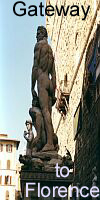

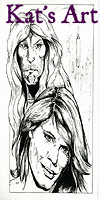
|
A guibone of amarante velvet lined with lavender tela (linen), trimmed with
'gold' bobbin lace bands (approximated). therealso a payre of maniche, lined
with 'gold satin', with downright panes bound with gold trim.
April, 2007. Update: May, 2008 (closures)
|
Inspiration: Right: Florentine School Lucrezia di Cosimo I, c.1555-60. The skirts were not visible on this guibone, so I interpretted them to suit the detailing.
This was made from left over cotton velveteen and braid purchased (25m)
some time ago, at a ridiculously cheap price. So more to use from my
stash of material and bits.... There was not enough for
a full lengh sleeve, so I adapted the sleeve pattern from
the Red Pisa Dress in La Grancduchessa, that I used for the dress.
The sleeves were initially to be made short in the style of 1550's
Florence, to fit over an existing sottana (1540s) with a puffed
baragoni (upper sleeve). A zimmarra would not fit such a sleeve. This
would transform the sottana to look more like a 1555-60 outfit that can
be worn with a highly decorated gorgeria (partlet) and hiding the
1540's sleeves.
|
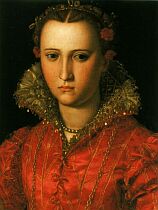
|
|
Pattern:
The pattern
for the guibone can be seen left, using the toile method. This was done
over the existing dress, so give a better fit. I used the chevron pattern from the portrait of Lucrezia, but
reversed it so it was more reminiscent of my device (Purpure, 3
chevronells braced). (Finally something I can use this motif on!)
As this guibone is a special case (having to fit over an earlier dress
to transform it), the sleeve toile was made over the rouched
sleeves, left. At this time, I decided to change the sleeve appearance,
from a double rouched sleeve (as in Lucrezia di Cosimo I, c.1555-60 above) to a more simpler sleeve on the right. Anguissola's SelfPortrait. (Note: not Florentine)
 |
Interlining Layers:
I did not have any felt left in
my material stash, at this point, so I substitued four layes of drill
for the interlining, to give stiffness. (left). The simpler sleeve
toile can be seen here too.
Right is the material that will be on show! Purple velveteen for a rich
look, and linen for lining. This will use up this remaining velveteen
from my material stash.
Left, is the lining, quilted together. This should make the guibone stronger and give stiffness.
|
 |
Outer Velvet Layer & Trim:
The outer layer was then added to the guibone. This involved a lot of
pins (2 boxes) and loss of blood! Rather than just pinning the trim
pattern lines, as originally thought,
I decided I am anaemic enough and stitched all of the lines for the
trim. (seen left).
The trim was handsewn onto the body of the guibone (right). Then the sleeves could be attended to.... a lot of handsewing again!
Sleeves:
The
sleeves are made from panels
with trim to match the main guibone. Unfortunately, the trim card
I had did not actually have the 20m that was marked on it. (I was about
5m short), so I could not do the herringbone pattern to match. The
panels were made from the same velvet and lined with linen. The trim
was handsewn in place. (right). They were mounted over a decorative
sleeve of
gold satin. Much of this was handsewn, as getting a sewing machine to
negotiate this was difficult. The cuff was also lined in linen
with the trim handsewn on. (lower right). After hours of
struggling and blood loss, I have got the sleeves have cuffs! (far
right).
 |
LINING :
The linen lining was 'hemstitched' into place rather than baglined. I
find it is less fiddly to handsew the lining in rather than sew with
the machine and turn inside out!
I also find the curves and corners are less bulky.
Examples of hemming in the lining can be found in Janet Arnold's Patterns of Fashion. |
Final Decorations and Closures:
 |
In the Florentine School Lucrezia di Cosimo I, c.1555-60 ( left) the front is closed with tied bows.
I made some cords from a simlar coloured cord, as the braid trim and
attatched some aglets I made from glass pearls and amethyst (from my
stash of bits). - below left.
Below, right is the finished guibone (doublet!!)
|
UPDATE: (MAY 2008) Far right
After wearing the guibone, I found it impracticle with the ties and
hook/eyes. I decided to go with my other option of buttons and loops.
The buttons were thread weaved over a wooden bead base. The loops were
fingerbraided and slipped through a hole made by a stiletto to keep the
material intact.
 |
After much thinking, I decided to add a partlet on the inside of the guibone to match the outfit.
(finally, the partlet was finished...seen on the right.)
I used an 'antique' hem stitch which has pulled threads, down the front of the partlet.
I used some freshwater seed pearls, that I was given at a Laurel prize tourney, on the collar of the partlet.
I am also toying with buttons on
the sleeve panels, as seen in this portrait of Eleanora
(found by the commission for looted art in eurpope). This is an
earlier sleeve (longer... the sleeves got shorter as the decades
passed, from 1550s). |


 |
Yes, projects do often metamorphose as they go... maybe, maybe not... watch this space...
Bibliography
- Ricci, Elisa. Old Italian Lace Volume 1. William Heinemann,
London. 1913 available on line:
http://www.cs.arizona.edu/patterns/weaving/books.html
- Kovesi Killerby, Catherine, Sumptuary Law in Italy 1200-1500,
Oxford University Press. NY. 2002. ISBN:0-19-924793-5
- Piponnier, Francoise & Mane, Perrine Dress in the Middle
Ages, Yale University Press, New Haven, 1997. ISBN: 0-300-08691-1
- Crowfoot E, Pritchard F & Staniland K, Textiles and
Clothing 1150-1450, Boydell Press, Woodridge, 2001 (ed) ISBN:
0-85115-840-4
- Arnold, Janet Queen Elizabeth's Wardrobe Unlock'd, Maney,
Leeds, 1988, ISBN:0-901286-20-6
- Arnold, Janet Patterns of Fashion, MacMillan, London, 1985.
ISBN: 0-333-38284-6
- Frick, Carole Collier. Dressing Renaissance Florence.:
Families Fortunes & Clothing. John Hopkins University Press.
Baltimore. 2002. ISBN: 0-8018-6939-0
- Jones, Ann Rosalind & Stallybrass, Peter. Renaissance
Clothing and the Materials of Memory. Cambridge University Press.
2003. ISBN: 0-521-78663-0
- L'Abito della Granduchessa; Vesti di corte
di Madonne nel Palazzo Reale di Pisa. Museo Nazionale di Palazzo Reale,
Pisa.
- Oonagh's Own: http://oonagh.actewagl.net.au/
- www.goldsword.com
- elizabethgeek.com
- Commission for Looted Art in Europe: http://www.lootedartcommission.com/lootedart_pressreleases.htm and (http://news.bbc.co.uk/1/hi/entertainment/5037002.stm)
All intellectual content, photos and layout are copyright to La
Signora Onorata Katerina da Brescia (K Carlisle), except those
original renaissance artworks and extant articles whose copyright
remains with the current owner and are for research purposes.
If you would like to use something from
this site, please contact me, and cite this website reference.
©(c) K Carlisle. April-July, 2007
|
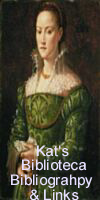
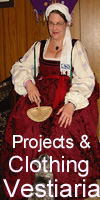
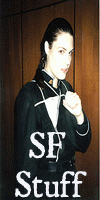
|